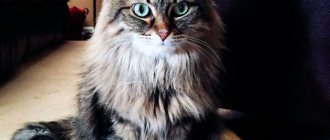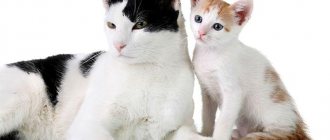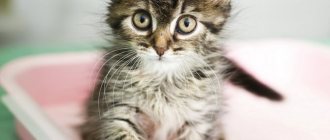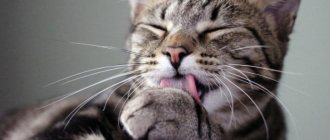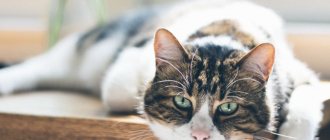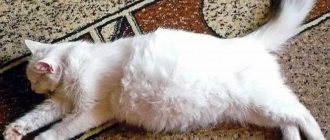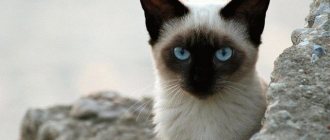For some reason, Persian cats and the breeds that are included in this group (Himalayan, exotic) are considered long-lived. They often live to the ripe old age of 20, but there is no official data on this. The lifespan of animals is influenced by many factors, from hereditary predisposition to living conditions.
Recommendations from competent breeders will help you figure out how to prolong the active life of a Persian cat at home.
How long do Persian cats live at home?
Persians are the most famous breed in the world, which came to Europe at the beginning of the 17th century. Since then, cats have changed a lot and now cannot live without human care.
The transformation was so powerful that the breed even lost its original phylogeographic signature and completely merged with the genetics of Western European cats.
According to Swedish pet life insurance companies, Persian cats live at home for approximately 12.5 years. Moreover, 76% do not even reach the age of 10, and the remaining quarter of the group matches the statistics.
English researchers give a different forecast - according to the version, the life period of cats of the Persian breed is limited to 12-17 years, and the average value is at 14.1.
It is known that the Persians had to undergo a serious change in appearance, which provoked a decrease in the life span of the animals. Persian cats were subjected to uncontrolled selection, as a result of which three varieties were developed (traditional, European and ultra flat-nosed).
They also received a number of diseases and forgot how to adapt to the environment. Against this background, a decrease in life expectancy looks like a natural result.
Life cycle of mustachioed pets
The entire life cycle can be divided into 6 stages
Please note that they are all very conditional. Many cats remain playful and active even in their old age.
Infancy (up to 1 month)
Until 1 month, the kitten is completely dependent on the mother. In the first days after birth, he is blind and toothless, so communication with the outside world is very limited.
Childhood (up to 7-8 months)
With the appearance of the first baby teeth, the kitten begins to show more independence. He tries his first complementary foods and is actively learning new things.
At 2.5-4 months, the baby finally leaves his mother and learns to live independently. His molars gradually grow and puberty begins. By 7-8 months, female cats are already in their first heat, but they are still babies until their third heat.
Youth (up to 4-5 years)
At this stage, breeders are actively breeding the breed. By age 5, most animals are removed for health reasons.
Maturity (up to 8 years)
The first behavioral changes appear. The cat becomes calmer and more reserved. She goes on crazy runs around the house less often, but still doesn't give up on games.
Old age (8-9 years and older)
At the final stage, there is a gradual attenuation of activity, an increase in sleep duration and the appearance of dental problems. The general well-being of the animal depends on the state of health.
In the absence of chronic diseases, significant changes are not observed. An elderly pet can be picky about food and show its devotion to its owner more clearly through affection and increased attention.
Factors influencing the health and life expectancy of Persian cats at home
In the mid-twentieth century, the Persian breed was overtaken by an unknown genetic mutation. Their already short snub noses became even smaller. Representatives of this branch were called “Peking”, although international felinological associations did not change the standard. They simply did not oppose the appearance of animals with new parameters at exhibitions and considered them the result of the natural development of the classic Iranian breed.
As a result of selection, three species of Persian cats were formed, in which the size, shape and position of the nose became the main distinguishing feature.
- In the classic group, a small straight nose is located below eye level.
- The European population reduced this part of the muzzle, introduced a snub nose and raised the nose in line with the lower eyelid.
- Extreme type - the nose rises to the upper edge of the eye.
It was later discovered that the lifespan of flat-faced Persian cats in domestic environments had decreased and they were developing health problems that had not previously existed.
- Shortness of breath and difficulty breathing - sometimes this symptom greatly worries the owners of Persian cats living at home. You have to urgently contact a veterinarian and constantly monitor the animal’s condition.
- Entropy – usually affects the lower eyelid, which folds inward. In this case, the cilia can rub and damage the cornea of the eye, causing injury, causing pain and infection.
- Another symptom that leads to similar consequences is trichiasis of the upper eyelid or nasal fold. Here the hair grows so close to the eye that it irritates the pupil and causes damage.
- Difficult childbirth - dystocia. It occurs quite often in the lives of domestic cats. The birth of dead offspring in the breed is now at the level of 16-22%.
Other diseases that affect the lifespan of Persian cats in the home are more common among other animals and are common to all breeds.
- The appearance of multiple cysts in the kidneys or polycystic disease (PKD) is a genetic disease that is expressed in the development of structural abnormalities of the renal tubules and the formation of cysts. At the end of the last century, pathology was diagnosed in half of the animals aged 3 to 10 years, which significantly shortened the lifespan of Persian cats at home. Thanks to the movement of animal activists, these catastrophic statistics were corrected. Most reputable breeders do DNA tests on animals and only breed those that do not have the PBP gene responsible for transmitting the disease.
- Cardiomyopathy is the inability of the heart muscle to pump blood normally due to thickening of the left chamber wall. The disease often leads to sudden death. It greatly affects how long castrated Persian cats live. After surgery, such animals are prone to gaining excess weight, which causes additional stress on the cardiovascular system. In some breeds (Maine Coon, American Shorthair), the genetic nature of this disease has been confirmed, but experts have also added Persian cats to this list.
Other illnesses are not so fatal, but they can also cause great anxiety for animal owners and take up time for treatment.
- Incorrect bite and inability to chew food normally.
- Reduced sensitivity level in the thermal protection area.
- Sebaceous adenoma is a slowly growing tumor on the skin of a Persian cat.
- Lupus erythematosus is a malfunction of the cat’s immune system.
- Various types of dermatological diseases associated with the anatomy of the muzzle in Persian cats.
This is interesting! The Persians have traditionally been involved in the selection of new breeding groups, and are largely responsible for the spread of genetic predisposition to certain types of diseases.
Prices
First of all, you should know that the cost of a Persian kitten ranges on average from 1,500 rubles to 8,000 rubles or more. The price depends on where you buy it: in a nursery, from private breeders, at an exhibition, or somewhere secondhand and without documents.
When choosing a kitten, you should pay attention to its appearance and behavior.
It is also worth familiarizing yourself with documents and information about hereditary diseases. And what is also important is the behavior of the seller. After all, if he does not ask you counter questions, then the fate of the kitten is of little interest to him, and he is pursuing only material gain.
You can buy a kitten from 1,500 rubles
The largest nurseries in Russia
- Anna's Cats
(Moscow) - Belinka
(Nizhny Novgorod) - Fluffy Joy
(Kazan) - Sigel
(Samara) - Irina Grezy
(Kaliningrad)
How to extend your pet's life at home
A set of preventive measures will help the cat live to old age, although it will not in any way affect the general negative development trends that plague this ancient and very beautiful breed.
Regular and timely prevention of diseases
Visits to the veterinarian should begin from the first days of the kitten’s life in its new home. The same recommendation applies to adult animals. Moving to a new place causes them real stress, which can result in physical health problems. Prolonged depression is often observed, which is extremely difficult to get rid of without the help of a specialist.
The lifespan of Persian cats at home is sometimes shortened due to their main external advantage - luxurious fur. The animals are very clean and constantly lick themselves. Microparticles of skin and hair enter the stomach and form thick lumps (trichobezoars).
The pet loses its appetite, becomes apathetic, and suffers from constipation. In later stages, body temperature rises and the urge to vomit appears. The danger is that all of the listed signs are universal for many diseases. The owner is unlikely to make the correct diagnosis at home.
Important! Every year, the Persian cat must be vaccinated with complex preparations and prevent the appearance of external (fleas) and internal (worms) parasites. This way you can protect the animal from many diseases and increase life expectancy.
Proper feeding
Persians do not express pickiness in choosing the daily menu, but problems with nutrition begin not with the food, but with the organization of the feeding area. Due to the characteristic short nose, it is necessary to choose wide bowls for food and drink, with small sides and a flat bottom (without a depression in the middle).
Neglecting these details will have an extremely negative impact on the emotional state of the Persian cat. She will be nervous, will not be able to feel comfortable, and will start throwing food around.
Just like for other breeds, felinologists recommend three types of nutrition for Persian cats:
- In childhood, preference is given to natural products - how long Persian kittens live on such a diet is determined by the owner himself, taking into account the physical condition of the pet.
- During the active period of life, the cat is transferred to industrial dry or wet food.
- In old age, the diet should be combined.
Important! You cannot feed your Persian cat fatty meat and bone-cartilaginous tissue, full-fat milk, spices and sweets, and some types of vegetables (eggplant, potatoes).
Hygiene and care
Due to the characteristic flat structure of the muzzle, the lacrimal glands in Persians are blocked, so the eyes and nose of the animal require careful care.
The ears are cleaned of wax deposits using cotton swabs or swabs, and the inside of the ear canal is treated with drops or lotions. White cats traditionally suffer from hearing problems or general deafness, which occurs in all breeds and is not considered an individual disadvantage of Persians.
Persian cats have very thin and long hair, which without proper care quickly forms untidy tangles. Therefore, you need to comb the animal daily, and during the period of active molting, this procedure is repeated several times a day.
Education and physical activity
Small Persian kittens are playful and active, which corresponds to the general idea of cats. With age, animals begin to behave more calmly. At the genetic level, this breed has character traits such as kindness and affection for humans.
Persian cats live long only at home, under the care of their owner.
Limiting stress factors
Felinologists do not officially recognize the influence of the mood and emotional state of animals on their health. However, owners of Persian cats notice a correlation between stress and possible physiological problems.
Any unexpected events can cause anxiety and irritation with subsequent nervous breakdown in Persians:
- change of residence and owner;
- loud noises or unexpected behavior;
- a sharp decrease (increase) in air temperature, change in humidity levels;
- chemical irritants (alcohol, tobacco, smoke);
- food stimulants (lack of nutrition, lack of vitamin and mineral support);
- emotional signs (transportation in a cage, the appearance of new people, a long break in communication, jealousy).
The manifestation of alarming symptoms depends on individual characteristics, but is most often characterized by increased breathing, diarrhea and frequent urination, as well as changes in temperature, and lack of appetite.
For domestic Persian cats, it is extremely important to prevent stress factors so as not to traumatize the psyche of a pampered pet. At such moments, he needs affection, participation, communication and attention from the owner.
He should gradually get used to constant irritants that will appear regularly in a cat’s life. This is how the fear of loud noises or intolerance to the carrier goes away. It will take several preliminary lessons, then the Persian cat will normally perceive such events.
Sterilization and castration, the effect of surgery on life expectancy at home
Uninformed people mistakenly believe that sterilization is performed on females and castration on males. In fact, the gender of the animal has nothing to do with the procedure. In the first option (sterilization), the fallopian tubes (for girls) or the seminal ducts (for boys) are ligated.
In the second case (castration), internal organs that are responsible for reproductive activity are removed from cats.
Castration affects how long Persian cats live:
- The hormonal levels change and the animals' appetite sharply increases - cats are prone to overeating with subsequent obesity.
- The risk of developing kidney stones increases.
Therefore, it is necessary to control the diet, volume and caloric content of portions. Manufacturers recommend special mixtures for such animals.
The operation has almost no effect on the lifespan of sterilized Persian cats. It is only necessary to organize a safe period after surgery. And if you follow the feeding rules, a neutered Persian cat will most likely live a very long life.
Character
The Persian cat is one of the most suitable for living in a family.
This breed is unlikely to survive in the wild. She is sociable: she gets along well with children, even the capricious and annoying ones. Falls in love with the owner once and for all: protects, heals and “worries” about the person. Persians are incredibly in need of love and affection, so they happily endure trips and relocations next to their beloved owner. While its owner is away, the Persian cat “freezes”: it may not touch food or drink, or even leave one place. But when someone from the family crosses the threshold, the pet literally comes to life! This breed takes care of its offspring like no other. Moreover, the Persian cat considers the owner to be “involved” in pregnancy and childbirth: while bearing offspring, she constantly shares her experiences with you, and after giving birth, she is sure that you must care for the cubs together - feed, play and lull the babies “in four hands.” However, the cat is simply torn between the need to be with her beloved owner and maternal duty
Conclusion: a pregnant and lactating Persian cat needs to be surrounded with even more attention and love. Temperament varies among Persians, but they are not aggressive. Persian kittens are always funny and restless, and they remain that way for many years if a person supports the cat’s playful behavior
In any case, this breed will never “talk back” to a person, calmly withstanding all the squeezing and hooting directed at it.
For “connecting” to the owner’s problems, the Persian cat often pays with a weak immune system.
Persians are a rather naive and curious breed. Therefore, they need special living conditions, such as:
- remove all medications and chemicals;
- When cooking, make sure that your pet does not jump onto the stove or hot dishes;
- check the washing machine and dryer - the cat can easily fall asleep there;
- Provide the windows with high-quality nets – this breed loves to sit on the windowsill.
Wool
Caring for the hair of a Persian cat is an entire art that requires special means and consistent actions.
Combing your pet takes place in several stages: we go over it with a thin comb, then carefully comb it with a medium comb and smooth it with a fine brush. Frequency – once every 2-3 days.
Conditioner or spray can be used during or at the end of the procedure, they will give your Persian's coat a healthy look and shine. Don't forget about cat antistatic agents.
It's time to find out what a Siberian cat is like - the character and other interesting features of the breed - under the picture.
And this article will teach you how to recognize and treat worms in domestic cats.
All about tablets for deworming in cats https://kotovasia.net/...79.html
Bathe your animal once every 2-3 weeks with a quality shampoo for long-haired cats.
After water treatments, pat the coat dry with a towel and gently comb it until completely dry, naturally, in a warm room.
Persian cats should be trimmed without touching the tail. But remember that you cannot cut colorpoint Persians to avoid pigmentation.
Nutrition
What to feed a Persian cat is one of the most important issues in keeping the breed. Ideally, you need to equally combine good food with homemade food:
- almost half of the diet is proteins (lean meat, fish, dairy, soybeans);
- carbohydrates (cereals, bread, root vegetables, oatmeal);
- necessary vitamins (olives, asparagus, boiled or raw vegetables, fruits).
The main thing is to keep seasonings and spices out of your cat’s diet.
A Persian can catch mice if this instinct is awakened in the kitten from 3 to 6 months.
Diseases
The Persian is a cat breed with fairly good health, but they have several hereditary diseases, for example:
- polycystic kidney disease;
- blindness (manifests by 4-8 weeks, after a couple of months the animal becomes completely blind);
- excessive tearfulness of the eyes due to a flat muzzle (need eye care - blotting with a napkin, treating with a special lotion);
- hypertrophic cardiomyopathy;
- Persian cats are also susceptible to gingivitis, the formation of tartar and plaque.
Your pet should be checked by a veterinarian every few months.
Famous Persians and long-lived breeds
There have never been real record-breaking pensioners among the Persians. Only one white tortoiseshell cat is reliably known to have lived up to 19.5 years.
But in art and cinema, Persian cats have a truly long and fruitful life:
- At Sotheby's auction they sold a painting by artist Karl Kahler (Austria), in which the main characters were 42 Persian cats.
- Florence Nightingale, the most famous English nurse, kept 60 Persians at home.
- Raymond Chandler (author of detective novels) read his works to the black Persian cat Taki.
The collection of admirers of magnificent long-haired beauties includes the legendary Cardinal Richelieu and Marilyn Monroe, the French monarch Louis XIV and Ernest Hemingway, the English Queen Victoria and musician Freddie Mercury.
Some difficulties in caring for long hair of Persian cats are more than compensated by their incomparable appearance, gentle character and boundless love for their owner. Under good housing conditions, they are able to live a long cat life, remaining healthy and active into old age.
Types of colors
These cats have dark black fur, undercoat, and usually have orange eyes.
Color point
Points of all shades are possible, with the obligatory presence of cream or ivory. Blue eyes.
White
Pure white coat color. The eyes are usually blue or orange, but other shades are also found.
It has lilac, chocolate, smoky with different shades, blue, black shades, blue, black shades.
The undercoat is silvery.
The color consists of evenly spaced spots of cream, blue, black and chocolate. The boundaries of the spots are not defined. Copper eyes.
The rich red color is uniform throughout the coat. Eyes the color of fur.
Conclusions about shorthaired exotics
It is not for nothing that the exotic shorthair cat has earned the love and respect of its fans. There are a lot of good things to say about the breed, but it’s worth considering all the pros and cons:
- The soft fur and fluffiness of plush wool are wonderful assets, but require care;
- large round eyes and the structure of the muzzle are the hallmark of the breed, although this brings some problems;
- if you monitor the health of cats, you can prevent many diseases and avoid unnecessary difficulties;
- The nature of the pets is affectionate and friendly.
As you can see, many people love the cutie exotic for its obvious advantages over other representatives of the cat world.
History of the origin of exotics
global $ads_google;
//data-ad-slot=”2475549904″ $ads_google = empty($ads_google) ? false : true; ?> if ($ads_google == false) {?> $ads_google = true; ?> } ?> The exotic cat today is included in the lists of popular and favorite breeds. And these amazingly cute cats turned out as a result of failure in the process of experimental selection. According to the letter of history, breeders decided to cross a Persian with an American Shorthair to get a greater variety of colors. But the result was not a Persian, not an American, but wonderful plush, almost toy-like, exotic kittens.
From the Persians they inherited the pretty expression of a childish, doll-like snub-nosed muzzle. They got their plush fur from their short-haired ancestors.
Strange, but the origin of these cuties was not very well received by supporters of purebred crossing, seeing this as an attempt to change the phenotype of the Persians. Fortunately, there were also admirers of the new breed, and soon work began on breeding a population of plush short-haired exotics. Not only the above-mentioned cats took part in it, but also Burmese and Russian Blue. Today they are recognized by the World Cat Fanciers Association.


